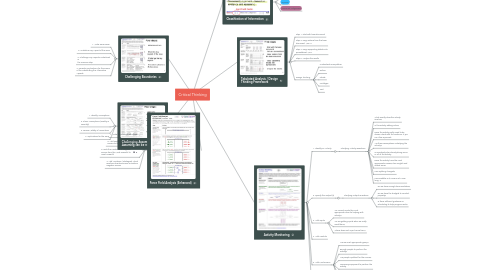
1. Challenging Boundaries
1.1. 1. Write Issue Down
1.2. 2. Underline Key Aspect of the Issue
1.3. 3. Challenge Key Aspects Underlined in the Previous Step
1.4. 4. Consider Implications for the eIssue of the Substituting the Alternative Aspects
2. Challenging Assumptions - Assuming can be restrictive
2.1. 1. Identify Assumptions
2.2. 2. Share Assumptions (Quality & Quantity)
2.3. 3. Review Validity of Assumtions
2.4. 4. Implications for the Issue
3. Force Field Analysis (Enhanced)
3.1. 1. Write the Change Issue Down
3.2. 2. Add Positive Drives and Negative Drivers to the Digram
3.3. 3. Rank the Positive and Negative Drivers from the Most Powerful to Least Powerful
3.4. 4. Add “Options” (Strategies) Which Reinforce Positive Drivers or Reduce Negative Drivers
4. Classification of Information
4.1. Fact
4.2. Opinion
4.3. Reasoned Judgement
5. Tabulated Analysis / Design Thinking Framework
5.1. Step 1: Start with base document
5.2. Step 3: Copy actions from the base document. WHAT
5.3. Step 4: Copy supporting details into spreadsheet. WHY
5.4. Step 5: Analyse the results
5.5. Design Thinking
5.5.1. Understand & Empathise
5.5.2. Define
5.5.3. Ideate
5.5.4. Prototype
5.5.5. Test
6. Activity Monitoring
6.1. 1. Identify an Activity
6.1.1. Clarifying Activity Questions
6.1.1.1. What exactly does the activity involve?
6.1.1.2. Is this activity adding value?
6.1.1.3. Does the activity really need to be done? Check with the customer. If yes can it be improved,
6.1.1.4. Are there assumptions underlying the activity?
6.1.1.5. Is somebody else already doing some or all of the activity.
6.1.1.6. Does the activity have the most appropriate names? Plain English and makes sense.
6.1.1.7. Has anything changed?
6.1.1.8. How scalable is it? How much, How long...?
6.2. 2. Specify the Output (s)
6.2.1. Clarifying Output Questions
6.2.1.1. Do we have enough documentation?
6.2.1.2. Do we have the budgets to conduct properly?
6.2.1.3. Is there sufficient guidance on scheduling to help program work?
6.3. 3. Add Inputs
6.3.1. Are current inputs the most appropriate ones fro helping with activity?
6.3.2. Are we getting inputs when we really need them?
6.3.3. Where does each input come from?
6.4. 4. Add Controls
6.5. 5. Add Mechanisms
6.5.1. Are we most appropriate group?
6.5.2. Enough people to perform the activity?
6.5.3. Are people qualified for the course?
6.5.4. Necessary equipment to perform the activity.
6.5.5. Do we have the facilities we need?
6.5.6. Are we in the best place to conduct the activity?
